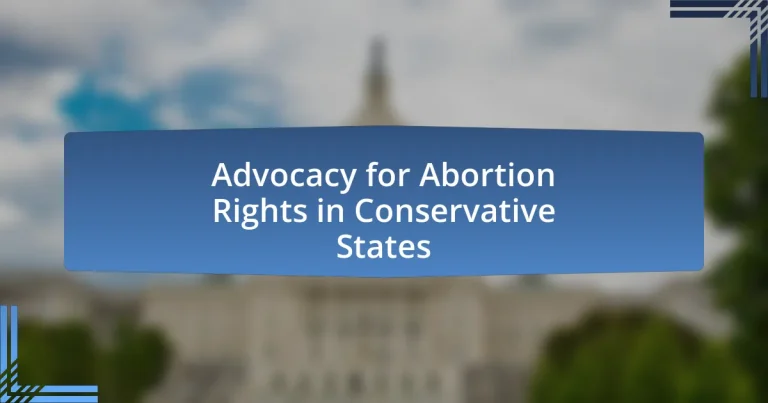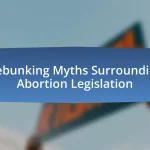Advocacy for abortion rights in conservative states focuses on promoting and protecting access to abortion services amid restrictive laws and cultural opposition. This article examines the importance of advocacy in these regions, highlighting the historical context, cultural attitudes, and legal barriers that shape the landscape of reproductive rights. Key players in the movement, including grassroots organizations and national entities, are discussed, along with effective strategies for mobilization and public education. The article also addresses the challenges advocates face, such as social stigma and political opposition, while outlining specific rights being fought for and the impact of advocacy efforts on policy change.
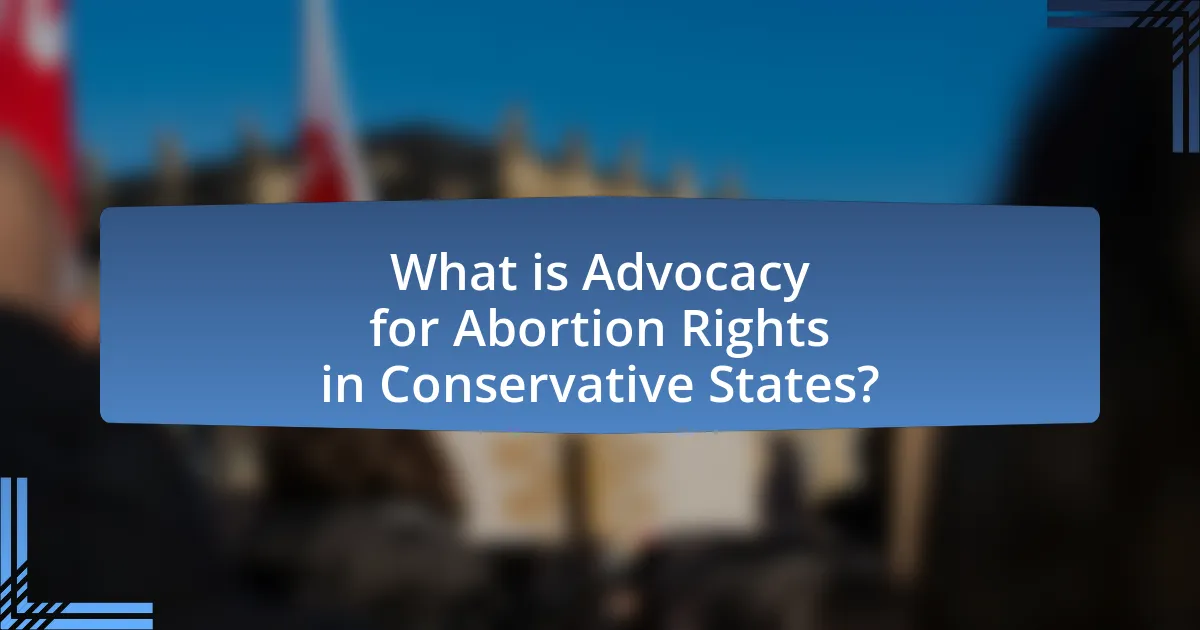
What is Advocacy for Abortion Rights in Conservative States?
Advocacy for abortion rights in conservative states involves efforts to promote and protect access to abortion services despite restrictive laws and cultural opposition. This advocacy often includes grassroots organizing, legal challenges, public education campaigns, and collaboration with national organizations to influence policy and public opinion. For instance, following the Supreme Court’s decision in Dobbs v. Jackson Women’s Health Organization in 2022, many conservative states enacted stricter abortion laws, prompting advocacy groups to mobilize for reproductive rights, highlighting the need for access to safe and legal abortion services as a fundamental aspect of healthcare and personal autonomy.
Why is advocacy for abortion rights particularly important in conservative states?
Advocacy for abortion rights is particularly important in conservative states because these regions often have stricter laws and limited access to reproductive healthcare services. In many conservative states, legislation frequently seeks to restrict abortion access, leading to increased barriers for individuals seeking these services. For instance, as of 2021, 13 states enacted laws that significantly limit abortion access, reflecting a trend that can endanger women’s health and autonomy. Furthermore, conservative states may lack comprehensive sex education and access to contraception, which can contribute to higher rates of unintended pregnancies, making advocacy essential to ensure that individuals have the right to make informed choices about their reproductive health.
What historical context influences abortion rights in these regions?
The historical context influencing abortion rights in conservative states includes a legacy of restrictive laws and cultural attitudes rooted in religious beliefs. For instance, many conservative states have enacted laws that reflect traditional views on family and morality, often influenced by religious groups that oppose abortion. The 1973 Supreme Court decision in Roe v. Wade initially established a constitutional right to abortion, but subsequent legal and political battles have led to a patchwork of state laws that vary widely in terms of access and restrictions. In recent years, many conservative states have passed laws aimed at limiting abortion access, citing moral and ethical considerations, which are often supported by historical narratives that prioritize fetal rights over women’s autonomy. This ongoing tension between state legislation and federal rulings continues to shape the landscape of abortion rights in these regions.
How do cultural attitudes shape the advocacy landscape?
Cultural attitudes significantly shape the advocacy landscape by influencing public perception, policy-making, and the strategies employed by advocacy groups. In conservative states, where traditional values often dominate, cultural attitudes towards abortion can lead to strong opposition against reproductive rights, thereby creating a challenging environment for advocates. For instance, a 2021 Pew Research Center study found that 61% of adults in conservative regions believe abortion should be illegal in most cases, which directly impacts legislative actions and funding for advocacy efforts. Consequently, advocacy groups must tailor their messaging and approaches to resonate with local cultural values, often focusing on personal stories and community engagement to shift perceptions and garner support.
What are the main goals of advocacy for abortion rights in conservative states?
The main goals of advocacy for abortion rights in conservative states include ensuring access to safe and legal abortion services, protecting reproductive rights against restrictive legislation, and raising public awareness about the importance of reproductive health. Advocacy efforts aim to counteract laws that limit abortion access, such as mandatory waiting periods and parental consent requirements, which disproportionately affect low-income individuals and marginalized communities. For instance, the Guttmacher Institute reports that states with restrictive abortion laws often see higher rates of unintended pregnancies and maternal health complications, highlighting the need for comprehensive reproductive healthcare access.
How do advocates define success in their efforts?
Advocates define success in their efforts as achieving tangible policy changes that expand access to abortion services and protect reproductive rights. This includes the passage of legislation that safeguards abortion access, the defeat of restrictive laws, and the mobilization of public support for reproductive rights. For instance, successful advocacy campaigns have led to the introduction of bills that enhance healthcare access and have resulted in court rulings that uphold abortion rights, demonstrating the effectiveness of strategic advocacy in conservative states.
What specific rights are being fought for?
The specific rights being fought for in the context of advocacy for abortion rights in conservative states include the right to access safe and legal abortion services, the right to make personal medical decisions without government interference, and the right to comprehensive reproductive healthcare. These rights are essential for ensuring that individuals can exercise autonomy over their bodies and reproductive choices. Evidence of this struggle is seen in various legal battles and legislative efforts aimed at protecting or expanding access to abortion services, particularly in states where restrictive laws have been enacted following the overturning of Roe v. Wade in 2022.
Who are the key players in the advocacy for abortion rights?
Key players in the advocacy for abortion rights include organizations such as Planned Parenthood, the American Civil Liberties Union (ACLU), and the Center for Reproductive Rights. These organizations actively work to protect and promote access to abortion services through legal challenges, public education campaigns, and lobbying efforts. For instance, Planned Parenthood provides reproductive health services and advocates for policy changes, while the ACLU focuses on legal battles to uphold reproductive rights. The Center for Reproductive Rights engages in international and domestic litigation to ensure that abortion remains accessible, highlighting the importance of these organizations in the ongoing fight for reproductive rights in conservative states.
What roles do grassroots organizations play?
Grassroots organizations play a crucial role in advocating for abortion rights in conservative states by mobilizing community support, raising awareness, and influencing policy change. These organizations often engage local populations through education campaigns, providing resources, and facilitating discussions that empower individuals to voice their concerns regarding reproductive rights. For instance, grassroots movements have successfully organized rallies and campaigns that highlight the impact of restrictive abortion laws, thereby increasing public awareness and pressure on policymakers. Research indicates that grassroots activism can lead to significant shifts in public opinion and legislative outcomes, as seen in various states where local organizations have effectively challenged restrictive abortion measures.
How do national organizations support local efforts?
National organizations support local efforts by providing resources, training, and funding to grassroots groups advocating for abortion rights. These organizations often conduct research to inform local strategies, share best practices, and mobilize national campaigns that amplify local voices. For example, the Planned Parenthood Federation of America offers grants and technical assistance to local affiliates, enabling them to effectively engage in advocacy and outreach. Additionally, national organizations may coordinate events and campaigns that raise awareness and generate public support, thereby strengthening local initiatives.
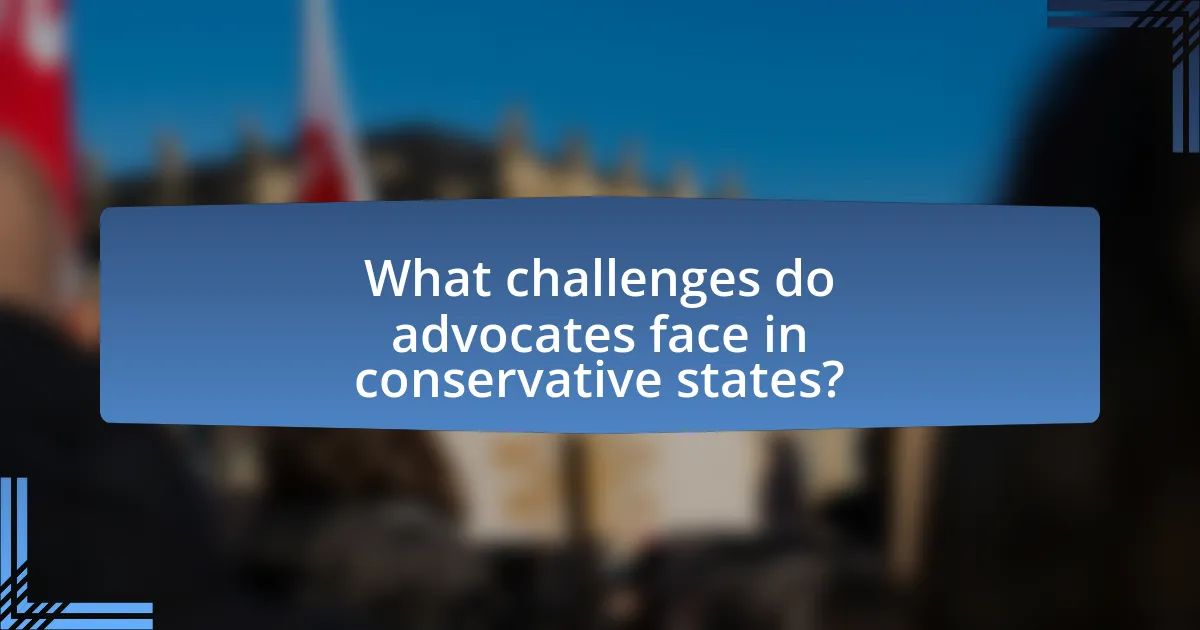
What challenges do advocates face in conservative states?
Advocates for abortion rights in conservative states face significant challenges, primarily due to restrictive legislation and cultural opposition. These states often enact laws that limit access to abortion services, such as mandatory waiting periods, parental consent requirements, and gestational limits, which can severely hinder a woman’s ability to obtain an abortion. For instance, according to the Guttmacher Institute, as of 2023, 26 states have enacted laws that significantly restrict abortion access, reflecting the political climate in conservative regions. Additionally, advocates encounter social stigma and hostility from local communities, which can lead to harassment and threats, further complicating their efforts to promote reproductive rights. This combination of legal barriers and societal pushback creates a challenging environment for advocates working to support abortion rights in these conservative states.
How do legal restrictions impact advocacy efforts?
Legal restrictions significantly hinder advocacy efforts by limiting the ability to organize, communicate, and mobilize support. For instance, laws that impose strict regulations on protests or require permits can create barriers for activists seeking to raise awareness about abortion rights. Additionally, restrictions on funding and resources can diminish the capacity of advocacy groups to effectively campaign and provide necessary services. Research indicates that states with more stringent abortion laws often see a decrease in public support for reproductive rights, as these legal frameworks can shape public perception and discourse around the issue.
What are the most common legal barriers encountered?
The most common legal barriers encountered in advocating for abortion rights in conservative states include restrictive legislation, mandatory waiting periods, and parental consent laws. Restrictive legislation often involves laws that limit access to abortion services, such as gestational limits and targeted regulations on abortion providers, which can lead to clinic closures. Mandatory waiting periods require individuals to wait a specified time before obtaining an abortion, creating additional obstacles. Parental consent laws necessitate that minors obtain permission from a parent or guardian, further complicating access. These barriers collectively hinder the ability to secure reproductive rights and access to safe abortion services in conservative regions.
How do these restrictions vary by state?
Abortion restrictions vary significantly by state, with some states imposing strict regulations while others maintain more lenient policies. For instance, states like Texas and Alabama have enacted laws that severely limit access to abortion services, including mandatory waiting periods, parental consent requirements, and gestational limits. In contrast, states such as California and New York have more protective laws that safeguard access to abortion, allowing it up to viability and beyond in certain circumstances. According to the Guttmacher Institute, as of 2023, 13 states have enacted total bans on abortion, while 16 states have laws that protect the right to abortion without significant restrictions. This disparity illustrates the complex landscape of abortion rights across the United States, influenced by political, cultural, and legal factors unique to each state.
What social and political opposition do advocates encounter?
Advocates for abortion rights in conservative states encounter significant social and political opposition primarily from religious groups and conservative political factions. These entities often mobilize to influence legislation, promote anti-abortion narratives, and rally public sentiment against abortion access. For instance, in many conservative states, laws restricting abortion have been enacted following campaigns led by organizations such as the National Right to Life Committee, which emphasizes moral and ethical arguments against abortion. Additionally, public opinion polls frequently show that a substantial portion of the population in these states supports restrictive abortion laws, further complicating advocacy efforts. This opposition manifests in legislative barriers, social stigma, and organized protests, creating a challenging environment for advocates seeking to promote reproductive rights.
How do conservative political agendas affect advocacy?
Conservative political agendas significantly restrict advocacy efforts, particularly in the context of abortion rights. These agendas often promote legislation that limits access to reproductive health services, thereby creating barriers for advocacy groups seeking to support abortion rights. For instance, many conservative states have enacted laws that impose strict regulations on abortion providers, such as mandatory waiting periods and parental consent requirements, which directly hinder the ability of advocacy organizations to operate effectively. According to the Guttmacher Institute, states with conservative leadership have seen a 50% increase in abortion restrictions since 2011, illustrating the tangible impact of these political agendas on advocacy efforts.
What strategies do opponents of abortion rights use?
Opponents of abortion rights use various strategies, including legislative measures, public campaigns, and legal challenges. Legislative measures often involve the introduction of restrictive laws aimed at limiting access to abortion services, such as mandatory waiting periods and parental consent requirements. Public campaigns frequently focus on promoting anti-abortion narratives through advertisements, social media, and grassroots organizing to sway public opinion against abortion. Legal challenges are employed to contest existing abortion rights, seeking to overturn landmark rulings like Roe v. Wade, which historically protected the right to abortion in the United States. These strategies are designed to create barriers to abortion access and influence societal attitudes towards the issue.
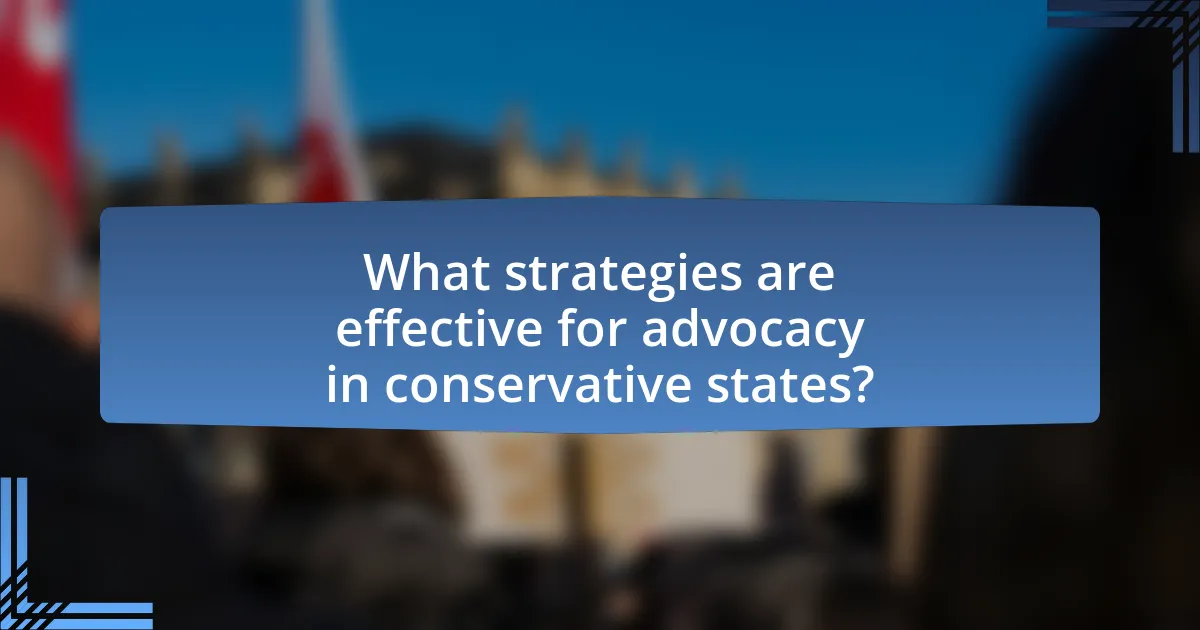
What strategies are effective for advocacy in conservative states?
Effective strategies for advocacy in conservative states include building coalitions with local organizations, framing the issue in terms of personal stories and health care, and engaging in grassroots mobilization. These approaches resonate more with conservative audiences, as they emphasize shared values and community impact. For instance, research shows that personal narratives can significantly influence public opinion, making the issue more relatable and less abstract. Additionally, collaborating with trusted local leaders can enhance credibility and foster acceptance of advocacy messages. Engaging in community dialogues and educational campaigns can also help demystify abortion rights, presenting them as part of broader health care access rather than a divisive political issue.
How can advocates build coalitions for greater impact?
Advocates can build coalitions for greater impact by identifying shared goals and values among diverse stakeholders. This approach fosters collaboration and strengthens collective efforts, as evidenced by successful coalitions like the Women’s March, which united various organizations to advocate for reproductive rights. By leveraging each member’s strengths and resources, advocates can enhance their visibility and influence, ultimately leading to more effective advocacy in conservative states.
What types of partnerships are most beneficial?
Collaborative partnerships between advocacy organizations, healthcare providers, and legal experts are most beneficial for promoting abortion rights in conservative states. These partnerships leverage diverse expertise to create comprehensive strategies that address legal, medical, and social barriers to access. For instance, organizations like the Center for Reproductive Rights work alongside local clinics and legal teams to provide resources and support, enhancing the effectiveness of advocacy efforts. This multi-faceted approach has been shown to increase awareness and mobilize community support, ultimately leading to more effective policy changes and improved access to reproductive healthcare.
How can intersectionality enhance advocacy efforts?
Intersectionality can enhance advocacy efforts by addressing the diverse and overlapping identities that individuals hold, which influence their experiences and needs regarding abortion rights. By recognizing how factors such as race, gender, socioeconomic status, and sexual orientation intersect, advocacy groups can tailor their strategies to be more inclusive and effective. For instance, research by the American Psychological Association highlights that marginalized communities often face unique barriers to accessing reproductive healthcare, including abortion services. This understanding allows advocates to create targeted campaigns that resonate with specific groups, ultimately leading to more comprehensive and impactful advocacy efforts.
What role does public education play in advocacy?
Public education plays a crucial role in advocacy by informing and empowering individuals about their rights and the issues at stake, particularly in the context of abortion rights in conservative states. It raises awareness about reproductive health, legal frameworks, and the implications of restrictive policies, thereby equipping citizens with the knowledge needed to engage in advocacy efforts. For instance, educational campaigns can highlight statistics showing the negative impacts of limited access to abortion services, such as increased maternal mortality rates, which can galvanize public support for policy changes. By fostering informed discussions and mobilizing community action, public education serves as a foundational element in the advocacy landscape, driving efforts to protect and expand abortion rights.
How can advocates effectively communicate their message?
Advocates can effectively communicate their message by utilizing clear, concise language and relatable narratives that resonate with their audience. Research indicates that storytelling can significantly enhance message retention and emotional engagement, making complex issues more accessible. For instance, a study published in the Journal of Communication found that personal stories can increase empathy and understanding, which is crucial in conservative states where abortion rights may be contentious. Additionally, employing data-driven arguments alongside personal anecdotes can strengthen the message, as statistics provide credibility and context. By combining emotional appeal with factual evidence, advocates can foster a more persuasive dialogue around abortion rights.
What methods are successful in changing public opinion?
Successful methods for changing public opinion include targeted messaging, grassroots mobilization, and leveraging social media platforms. Targeted messaging involves crafting specific narratives that resonate with the values and beliefs of the audience, which has been shown to effectively shift perspectives on contentious issues like abortion rights. Grassroots mobilization engages community members directly, fostering personal connections and encouraging dialogue, which can lead to increased support for abortion rights in conservative areas. Social media platforms amplify these efforts by allowing advocates to reach wider audiences quickly, facilitating the spread of information and personal stories that humanize the issue. Research indicates that campaigns utilizing these methods can significantly influence public attitudes, as evidenced by the success of organizations like Planned Parenthood in changing perceptions around reproductive rights through strategic outreach and education initiatives.
What practical steps can individuals take to support abortion rights advocacy?
Individuals can support abortion rights advocacy by engaging in grassroots organizing, donating to relevant organizations, and participating in local and national campaigns. Grassroots organizing involves mobilizing community members to raise awareness and advocate for policy changes, which can significantly influence public opinion and legislative action. Donating to organizations such as Planned Parenthood or the Center for Reproductive Rights provides essential funding for legal battles and educational efforts. Additionally, participating in campaigns, such as rallies or letter-writing initiatives, amplifies the message and demonstrates public support for abortion rights. According to a 2021 report by the Guttmacher Institute, states with active advocacy efforts have seen more favorable legislation regarding reproductive rights, highlighting the impact of individual involvement.
